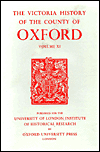A History of the County of Oxford: Volume XI: Wootton Hundred (Northern Part)
This volume contains the histories of 19 parishes in the northern part of Wootton hundred, stretching from Stonesfield, Wootton, and Tackley in the south to Deddington, Barford St. Michael, and South Newington in the north; the other parishes are Glympton, Heythrop, Rousham, Sandford St. Martin, the Astons, the Bartons, the Wortons, and the three Tews. The area, bounded on the east by the river Cherwell and on part of the west by the river Glyme, containsthe small, well documented, market town of Deddington, two outstanding country houses at Heythrop and Rousham, and many other notable secular and ecclesiastical buildings. Probably the best known village is Great Tew, whose development is here reinterpreted in the light of new evidence. The many deserted village sites in the area are treated in detail, and special attention has been given to the arrangement of open fields, of which a local feature was thedevelopment within a single vill of two separate sets of fields, known as ends or sides, as at Deddington, Duns Tew, and South Newington. The complex arrangements for the periodical division of common meadows are well documented in some parishes, particularly North Aston. A feature of religious life in the area was the establishment at Nether and Over Worton in the early 19th century of a strong, locally influential, tradition of evangelical Anglicanism. The volume is illustrated with 20 pages of plates, two church plans, and numerous parish and village maps.
1126063014
A History of the County of Oxford: Volume XI: Wootton Hundred (Northern Part)
This volume contains the histories of 19 parishes in the northern part of Wootton hundred, stretching from Stonesfield, Wootton, and Tackley in the south to Deddington, Barford St. Michael, and South Newington in the north; the other parishes are Glympton, Heythrop, Rousham, Sandford St. Martin, the Astons, the Bartons, the Wortons, and the three Tews. The area, bounded on the east by the river Cherwell and on part of the west by the river Glyme, containsthe small, well documented, market town of Deddington, two outstanding country houses at Heythrop and Rousham, and many other notable secular and ecclesiastical buildings. Probably the best known village is Great Tew, whose development is here reinterpreted in the light of new evidence. The many deserted village sites in the area are treated in detail, and special attention has been given to the arrangement of open fields, of which a local feature was thedevelopment within a single vill of two separate sets of fields, known as ends or sides, as at Deddington, Duns Tew, and South Newington. The complex arrangements for the periodical division of common meadows are well documented in some parishes, particularly North Aston. A feature of religious life in the area was the establishment at Nether and Over Worton in the early 19th century of a strong, locally influential, tradition of evangelical Anglicanism. The volume is illustrated with 20 pages of plates, two church plans, and numerous parish and village maps.
115.0
In Stock
5
1

A History of the County of Oxford: Volume XI: Wootton Hundred (Northern Part)
368
A History of the County of Oxford: Volume XI: Wootton Hundred (Northern Part)
368Hardcover
$115.00
115.0
In Stock

Product Details
| ISBN-13: | 9780197227589 |
|---|---|
| Publisher: | Boydell & Brewer, Limited |
| Publication date: | 01/01/1983 |
| Series: | ISSN |
| Pages: | 368 |
| Product dimensions: | 8.19(w) x 12.01(h) x (d) |
About the Author
From the B&N Reads Blog
